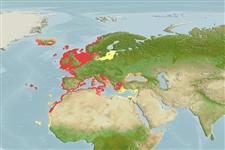>
Clupeiformes (Herrings) >
Alosidae (Shads and Sardines)
Etymology: Sardina: Latin and Greek, sarda = sardine; name related to the island of Sardinia (Ref. 45335).
More on author: Walbaum.
Environment: milieu / climate zone / depth range / distribution range
экология
морской; пресноводный; солоноватоводный; мигрирует в океане (Ref. 51243); пределы глубины 10 - 100 m (Ref. 5286), usually 25 - 100 m (Ref. 54866). Subtropical; 68°N - 14°N, 32°W - 43°E (Ref. 54866)
Northeast Atlantic: Iceland (rare) and North Sea, southward to Bay de Gorée, Senegal. Mediterranean (common in the western part and in Adriatic Sea, rare in the eastern part), Sea of Marmara and Black Sea.
Length at first maturity / Size / Вес / Возраст
Maturity: Lm 14.8 range ? - ? cm
Max length : 27.5 cm SL самец/пол неопределен; (Ref. 74552); common length : 20.0 cm SL самец/пол неопределен; (Ref. 188); наибольший возраст (опубликованны данные): 15 годы (Ref. 35388)
колючие лучи спинного плавника (общее число) : 0; членистые (мягкие) лучи спинного плавника (общее число) : 13 - 21; колючие лучи анального плавника: 0; членистые (мягкие) лучи анального плавника: 12 - 23. Body sub-cylindrical, belly rather rounded (but more compressed in juveniles). Hind margin of gill opening smoothly rounded (without fleshy outgrowths) ; 3 to 5 distinct body striae radiating downward on lower part of operculum; lower gill rakers not becoming shorter at angle of first gill arch, the upper series not overlapping the lower. Last 2 anal fin rays enlarged.
Littoral species (Ref. 6808). Form schools, usually at depths of 25 to 55 or even 100 m by day, rising to 10 to 35 m at night. Feed mainly on planktonic crustaceans, also on larger organisms. Spawn in batches (Ref. 51846), in the open sea or near the coast, producing 50,000-60,000 eggs with a mean diameter of 1.5 mm (Ref. 35388). Marketed fresh, frozen or canned. Also utilized dried or salted and smoked; can be pan-fried, broiled and microwaved (Ref. 9988).
Breeds at 20 to 25 m, near the shore or as much as 100 km out to sea.
Whitehead, P.J.P., 1985. FAO Species Catalogue. Vol. 7. Clupeoid fishes of the world (suborder Clupeoidei). An annotated and illustrated catalogue of the herrings, sardines, pilchards, sprats, shads, anchovies and wolf-herrings. FAO Fish. Synop. 125(7/1):1-303. Rome: FAO. (Ref. 188)
Статус Красного Списка МСОП (Ref. 130435: Version 2024-2)
Угроза для людей
Harmless
Использование человеком
рыболовство: важный объект промысла
дополнительная информация
инструменты
Специальные отчеты
Скачать в формате XML
ресурсы в Интернет
Estimates based on models
Preferred temperature (Ref.
123201): 7.1 - 17.3, mean 10.3 °C (based on 553 cells).
Phylogenetic diversity index (Ref.
82804): PD
50 = 1.0000 [Uniqueness, from 0.5 = low to 2.0 = high].
Bayesian length-weight: a=0.00631 (0.00554 - 0.00719), b=3.08 (3.04 - 3.12), in cm total length, based on LWR estimates for this species (Ref.
93245).
Trophic level (Ref.
69278): 3.1 ±0.1 se; based on diet studies.
Generation time: 3.0 (2.7 - 3.2) years. Estimated as median ln(3)/K based on 58
growth studies.
устойчивость к внешним воздействиям (Ref.
120179): средний (среднего размера), минимальное время удвоения популяции 1.4-4.4 года (K=0.23-0.5; tm=1-2; tmax=15).
Prior r = 0.63, 95% CL = 0.41 - 0.94, Based on 26 full stock assessments.
Fishing Vulnerability (Ref.
59153): Low to moderate vulnerability (30 of 100).
Climate Vulnerability (Ref.
125649): Low vulnerability (22 of 100).
Nutrients (Ref.
124155): Calcium = 162 [75, 357] mg/100g; Iron = 2.61 [1.10, 5.76] mg/100g; Protein = 19.8 [18.6, 21.0] %; Omega3 = 1.07 [0.55, 2.10] g/100g; Selenium = 35.9 [18.2, 74.0] μg/100g; VitaminA = 14.5 [4.5, 48.3] μg/100g; Zinc = 1.42 [1.02, 2.25] mg/100g (wet weight); based on
nutrient studies.
